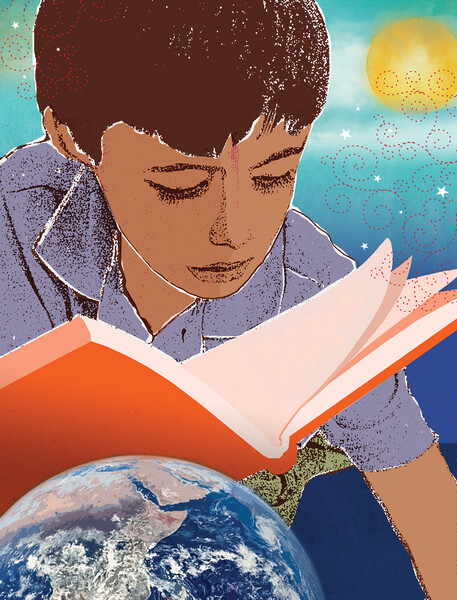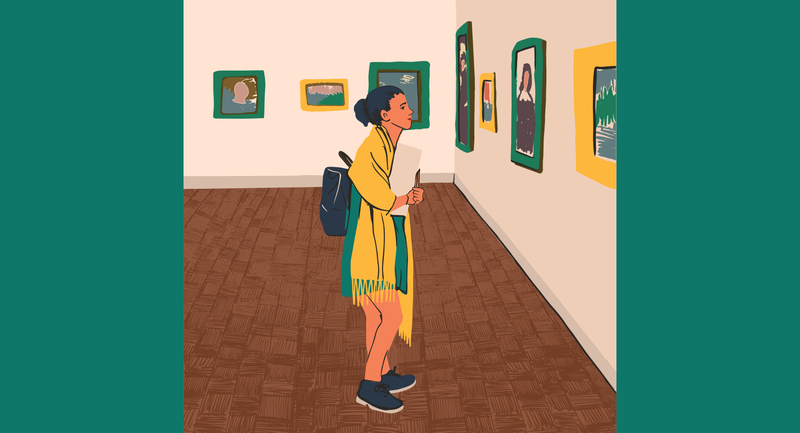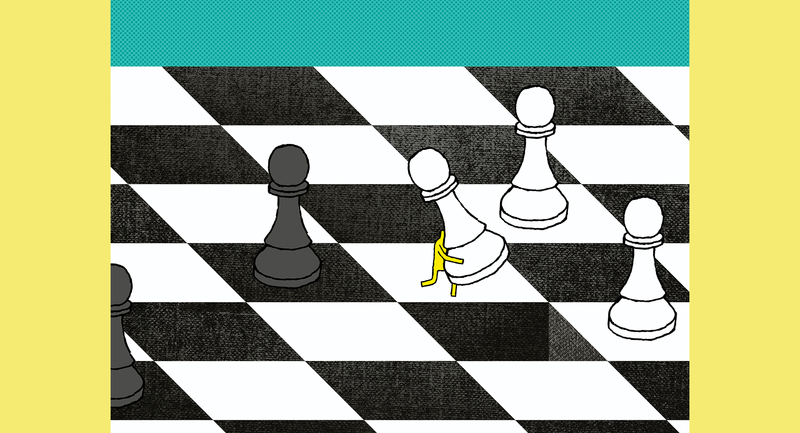"We've had a week of school and haven't read anything yet in ELA …. We spend a lot of time in class going over homework (mostly vocabulary, some grammar) so we haven't had time to read yet … I [would] like it more slow." —a 6th grader
Children's school lives are busy. Feeling pressure to ensure efficiency in the name of student engagement and performance, educators today are faced with accounting for every second of the school day. This rationalization of time in schools isn't new (Myers & Berkowicz, 2015; Silva, 2007), but the push for "measurable outcomes" (that is, the quantification of student learning) has intensified the ways time is understood, (mis)used, and experienced by children and teachers.
The pace of children's lives doesn't necessarily slow down at home either. Although Americans are actually working less than they did during the agrarian-industrial economy of 100 years ago (Thompson, 2014), there is a growing, pervasive feeling of busyness that is now an acute part of 21st century family life. There is speculation that this busyness, combined with distractions of ubiquitous technology, makes us shallow thinkers unable to focus on one thing or read at length (Carr, 2010).
Within this growing culture of busyness, we believe schools have an important counter role to play. One critical antidote to this epidemic of overload is to reorient reading instruction to cultivate intentionally present, mindful readers through classroom time dedicated to engaging in immersive reading. This intersection between reading and mindfulness is highlighted by David Ulin (2009) in his book The Lost Art of Reading, in which he proposes that reading "is an act of contemplation … an act of resistance in a landscape of distraction" (p. 7, emphasis added). Explicitly and implicitly, one of the main messages children learn in school is the importance of producing "good work fast" (Adam, 1995). But reading, as (re)framed by Ulin, invites educators to consider how slowness—or mindful contemplation—might be modeled and valued within classrooms' reading pedagogy.
Mindfulness offers tools for helping children lead engaged, literate lives outside of school. Children today not only need to learn about how to read across print and digital texts, they also need to learn rituals for slowing down and intentionally "allocat[ing] time to the processes" (Wolf, 2018, p. 38) needed to experience reading as an immersive activity in an ever busier world filled with distractions.
Cognitive neuroscientist and psycholinguist Maryanne Wolf (2018) asks (of adults and children) a central question about reading habits today:
… are you less able to find the same enveloping pleasure you once derived from your former reading self? Have you, in fact, begun to suspect that you no longer have the cerebral patience to plow through a long and demanding article or book? (p. 96, emphasis added)
As educators, we must do something to counteract the push for fast reading. We must look at not only how we are creating the time for slow reading in our classrooms (Newkirk, 2010), but also how we are equipping children to engage in the kinds of immersive reading that allow for enveloping pleasure outside of school, where digital distractions are even more omnipresent.
Five Intentions to Foster Immersive Reading
In the following sections, we offer five intentions, flexibly adaptable across grades K–6, to help teachers cultivate children's slow, mindful reading habits and practices. We borrow the term "intention" from mindfulness literature to intentionally disrupt the inclination to see this list as a kind of goal-oriented, outcome-focused checklist. In our view, the pervasive feeling of busyness overwhelming teachers, families, and children alike necessitates a need for attentiveness rather than increased efficiency. Unlike goals and outcomes that are oriented toward the future, intentions are rooted in the present moment, offering ways to think differently today.
By inviting attentiveness through clearly stated intentions, students and teachers have the chance to reflect, feel, adapt, and be the kind of readers who make time and space to read in a world filled with distractions. It is through daily practice that intentions are realized.
Each intention begins with a script that a teacher might use to activate mindfulness practices into children's reading lives.
1. Prioritize Time
I know myself as a reader, and I do my best, sharpest reading and thinking about books in the morning. I even read a few pages in bed to wake up my brain in the morning. Before I open up a good book, I take a big breath and focus to get into a compelling story. When will you make time to read, and how do you get your mind ready?
Setting aside intentional time for immersive reading each day during literacy block signals its importance to children. This means treating immersive reading time as a sacred priority not to be skipped or shoved aside. Quality of time, not quantity, is what counts. Time can be bracketed intentionally for children, so it's not just "9:00–9:30 a.m.: free choice reading time," but a mind shift.
In the classroom, time for reading can be used intentionally in a variety of ways. First, scheduling: we all have a time of day when we do our best reading. For example, children's "peaks" and "slumps" fluctuate predictably during the day according to their circadian rhythms. Knowing this is key to knowing our students as readers-writers-thinkers. In his 2018 book When: The Scientific Secrets of Perfect Timing, Daniel Pink suggests that being intentional about beginnings and endings is important to segmenting time meaningfully. Put immersive reading in the morning—during the peak—when most children's minds are sharper. Intentional beginnings might also mean starting with a quiet pause to focus on the one thing to accomplish now: getting deep into a book. At the close of immersive reading, include meaningful endings: integrate reflection, a silent pause, and time to place a bookmark, and children will be more likely to jump right in next time.
2. Feel the Story
Readers, every day I'm going to spend time sharing a book that really touches my heart … making me joyful, sad, or a combination of feelings. While I'm reading, I want you to pay attention to words and sentences that spark feelings for you. That is often a clue that you should pay extra attention, because books that make us feel are often books that are teaching us something important.
Emotions are key to immersive reading. Mindfulness teaches the importance of paying attention to the range of emotions that wash over us, with distance and nonjudgement that is often not associated with experiencing emotions (Cameron, 2018). By being present with, but not captive to, the emotions that situations, interactions, and a range of texts evoke, young people are able to metacognitively make sense of how particular situations and texts might trigger moments of growth, new understandings, and richer, fuller lives.
In the classroom, create a virtual or physical "wall of joy," a space to capture sentences and words that students encounter in texts that bring them aesthetic or intellectual pleasure. Find ways to integrate socioemotional curriculum into your literacy block. For example, if you are teaching about how to manage feelings of anger productively, have students share moments in books that have sparked a sense of injustice or anger for them. Help them make sense of how anger might be productive rather than destructive. What might it teach them? Foster opportunities to make text-to-self/world connections. When they feel sad, what kinds of books are they drawn to? Why?
3. Consider Environment
Readers, look at our classroom library: books are surrounding us on all sides, they're hugging us. This spot really inspires me to read, so I'm going to choose this spot for my reading time. Where are some other places that inspire you to slow down and give reading your full attention? … Look around this room: we have several options for where to read, and today we're going to try reading in a spot besides our desk …. Where are some places you can think of where you might snuggle up with a book at home?
While immersive reading might happen anywhere, creating an environment that engages the senses to slow down is important—sensory-based and place-based memories are the "stickiest." Leverage physical and sensory components—like sound, smell, and surroundings—to create reading spaces at school that children can replicate at home. Model assessing good-fit reading spots at the start of the year. Invite children to identify places outside of school they'll plan to read and share examples of children successfully creating their own reading spots, like under a table at home, under a tree in the yard, or in the children's section at the local library.
In the classroom, consider integrating rituals for the physical environment—sound, lighting, scent, and where-to-sit—that signal, this is our reading time. Ring a chime or breathe in and out slowly to start and close slow reading time, dim the lights or invest in alternative lighting, click on a small oil diffuser with lavender or peppermint scent—all are options for stepping into an immersive reading mind-set. Sitting up straight at a desk isn't always the best option for focus: Allow children to select and stick to a reading spot around the room (or school! or outdoors!) and check in periodically on that choice. Add a reading tent, loft, or cave (cardboard box) and rotate rights to rest inside with a book, pillow, and lantern.
4. Invite Conversation and Interaction
I love getting book recommendations from my sister: we text each other titles all the time. Today she recommended Hunger Games. I picked up the whole series from the library so we can read together! You can share books like that, too. Who are some friends you know who you can rely on for great book recommendations or discussions?
There is often a sense of wanting—no, needing—to talk with another person about a book, article, or recipe. Reading is both intensely personal and fundamentally social as we work through books collaboratively in book clubs, email message boards, and even chat back and forth in text messages. Similarly, classrooms need to provide students with opportunities both to explore texts on their own and to talk about those experiences.
In the classroom, create opportunities for students to talk about books with their peers and adults. Set students up with skills to engage with others around text, both informally—in a book club, for instance—and more formally. Students should be equipped to write about their reading, and to share their likes, dislikes, and wonderings about books. Truly engaging books will evoke a need in students to talk with others. It is important to have texts students will be willing to invest time in because they are compelling and reflective of contemporary concerns. Are there multiple copies of texts available for students to read in groups? Are student voices accounted for when purchasing books for the school library? Are there systems in place for readers to meet and discuss the same (or different) books with a peer or group of peers?
5. Honor Choice
In this classroom, you are allowed to pick books that you love. You're also allowed to stop a book sometimes if you don't love it. That's called choice. Choice during part of our reading time is a really important part of being a reader.
Cartoonist Dav Pilkey recently reflected, "reading without judgement was a turning point in my life" (Charles, 2018). Make sure students have opportunities to read widely and freely, in accord with their own interests and enthusiasms. Awareness of childhood culture is key; oftentimes, children are drawn to texts from popular culture franchises or ongoing series. In truth, adults engage with a wide and variable range of reading materials (books, websites, magazines, and so on). The chance that all these materials are "on level" for us or of "high quality" is small—and yet students' reading materials are often sorted that way. We need to honor choices students make in their reading materials when choice is offered as an option.
In the classroom, there is a difference between making choices for students and making them aware of the choices they have available to them. Audit the classroom library, asking how the texts reflect student interests. Which books can be removed, placed into storage, or circulated more frequently? Do you have enough copies of books children are swapping and fighting over? Model choice in your own reading life. Talk about how reading materials have come into your life through the recommendations of others, as well as how pluralistic takes on readings—such as where your opinion of a text has diverged from that of the person recommending it—can create inroads to readings we may never have picked up before and create deeper understandings of our own preferences.
A Restorative Practice
In sum, slow reading has a multitude of benefits that can combat the onslaught of hurried and disconnected information bombarding children. By cultivating intentional, immersive reading practices, schools can improve stamina, resist burnout, and restore balance. We hope that through these five intentions, children will become more independent in self-regulating their use of reading time, both inside the classroom and outside of school.
Reflect & Discuss
➛ Has technology changed the way your students read? If so, in what ways?
➛ What clues help you determine if a student is truly immersed in a book? How do you get an unengaged student back on track?
➛ Which of the five practices/habits that the authors outline could help you foster a culture of slow reading in your classroom?









